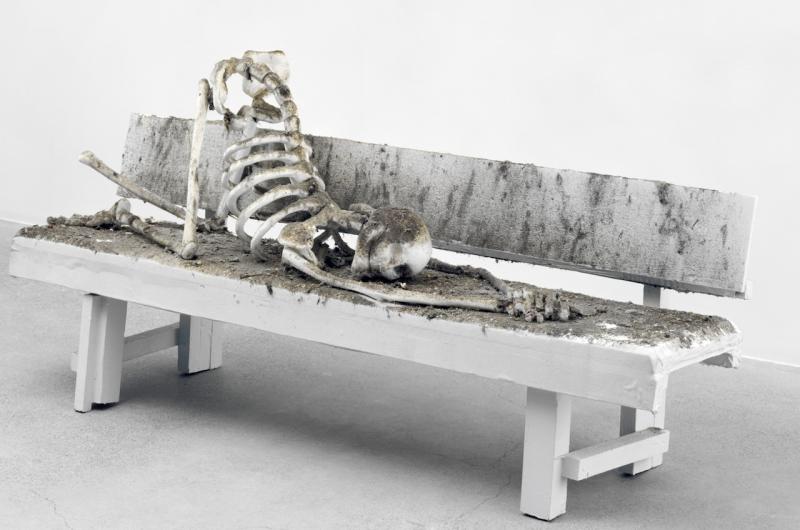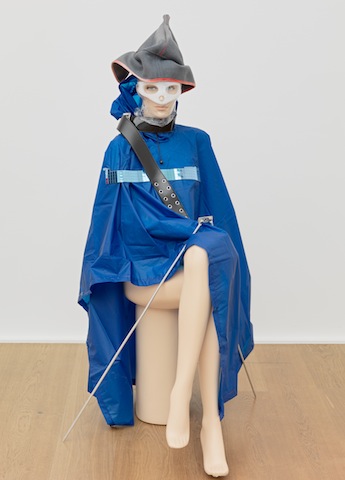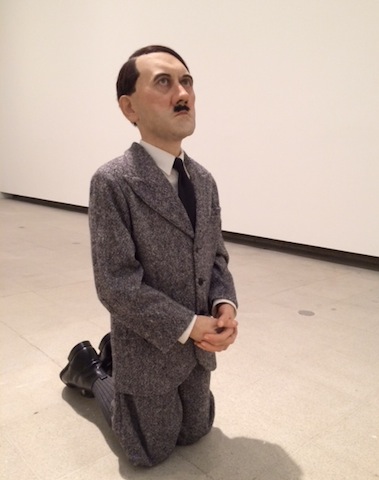The Human Factor, Hayward Gallery | reviews, news & interviews
The Human Factor, Hayward Gallery
The Human Factor, Hayward Gallery
An exhibition of contemporary sculpture featuring the human figure tries hard to be cool

When a large and ambitious group exhibition is mounted on a particular theme or subject, in this case the human figure in contemporary sculpture, it’s always interesting to note what gets left out as well as what goes in. It’s reasonable to ask what story is being promoted under the heading of a general survey. Here are 25 sculptors, all but one from Europe and America, spanning the past 25 years.
I'd like to imagine a gallery meeting in which Gormley is discussed but swiftly ruled out by a unanimous verdict. “Too naff,” comes the resounding conclusion. "We really want to be cool," the curatorial voice whispers guiltily. (Incidentally, Gormley did have a Hayward solo show in 2007, though this perhaps makes his absence more telling – his currency, both critical and in terms of art world fashionability, has dropped even further since then). And then we have other British artists such as Ron Mueck, whose hyper-realist sized-up–sized-down figures also had their moment – particularly during the time he exhibited at the Royal Academy’s Sensation exhibition with Dead Dad. He also doesn't make the cut.
To step into the hyper-realist vacuum we have, instead, the heavy-weight LA artist Paul McCarthy, with a trio of startlingly life-like nubile nudes, of the same young and beautiful model, fabricated with casts and realised with special effects by a team of Hollywood studio artists and technicians. The dead-eyed replicants sit, legs wide apart, atop tables whose thick glass surfaces reflect the seductive outline of limbs. A Hollywood wax (the one that doesn't leave even an airstrip) allows the neat folds of vulval flesh full exposure.
But all these nubile nudes are so atypical of McCarthy’s work, which is rooted in hair-raisingly "debased" performances and latterly rages against George W Bush (last seen as triplicate apparitions mechanically humping a pig) that again you are forced to reflect on the choices.
it's not just the fashionable that's being pushed, but there's the wider politics too, and I'm really not sure the politics is that interesting. There are shop mannequins – lots of manky shop mannequins, the kind you hardly see anymore except in charity shops – which raises the usual issues about consumerism, ideals of beauty and physical perfection, capitalism and the body commodified. John Miller’s homoeroticised male mannequin, dressed in an old-fashioned bathing suit and with a plaster prominently displayed on one cheek, poses with a hand on his hip and one foot in a heap of brown muck. Its oppositions are a little obvious, and it’s really among the weakest work in the exhibition. But because the curator, Hayward director Ralph Rugoff, has been eager to find forms, modes and ideas that echo one other, even the best work can be reduced to this kind of polemic.
 Yet Isa Genzken’s mannequins really exist as a thing apart; they appear to express a very personal kind of visual idiom. One female dummy (pictured right) sits draped in a ridiculous makeshift garment, with a cheap studded belt worn like a sash. The face is behind a paper mask edged with some flimsy clear plastic, so that it’s completely behind cover, and there's a long two-pronged metal implement balanced on her knee. One might think of the compass in Blake’s Newton or his ancient Urizen figure, measuring and reducing the world down to its own rigid logic, for that is what the object resembles. But here it is transformed into a wand. She is a high priestess or a sacrificial subject – she could be both. Like Blake, Genzken appears to have her own private mythologies and partly exists in some otherwordly realm.
Yet Isa Genzken’s mannequins really exist as a thing apart; they appear to express a very personal kind of visual idiom. One female dummy (pictured right) sits draped in a ridiculous makeshift garment, with a cheap studded belt worn like a sash. The face is behind a paper mask edged with some flimsy clear plastic, so that it’s completely behind cover, and there's a long two-pronged metal implement balanced on her knee. One might think of the compass in Blake’s Newton or his ancient Urizen figure, measuring and reducing the world down to its own rigid logic, for that is what the object resembles. But here it is transformed into a wand. She is a high priestess or a sacrificial subject – she could be both. Like Blake, Genzken appears to have her own private mythologies and partly exists in some otherwordly realm.
Elsewhere one meets a mini Hitler (pictured below left), on his knees in prayer, and a dead JFK in his coffin, both by Maurizio Cattelan, an artist who makes light work of heavy subjects. We find Cady Noland’s Bluewald, a half-figure effigy of JFK assassin Lee Harvey Oswald at the precise moment he is shot by Jack Ruby. Holes the size of tennis balls puncture the figure, like a fairground target, and the mouth is gagged by a balled-up American flag – as if truth is being gagged forever with Oswald’s death (conspiracy theories die hard). I’m not sure why Noland's piece is a much more powerful work in reproduction. Perhaps because there’s the cheapening effect of a gimmick elaborated in the finished 3-D object.
 Then there’s Mark Wallinger’s Christ, in Ecce Homo, bought down to earth, or at least down from his column, where we last saw him perched on the edge of Trafalgar Square’s Fourth Plinth in 1999. There he looked small and vulnerable. Here Christ looks robust and with a surprisingly wide chest. Nearby is Urs Fischer’s Skinny Sunrise (main picture), a skeleton stretched face down on a park bench with its arse in the air, as if doing its yogic exercises for health and longevity.
Then there’s Mark Wallinger’s Christ, in Ecce Homo, bought down to earth, or at least down from his column, where we last saw him perched on the edge of Trafalgar Square’s Fourth Plinth in 1999. There he looked small and vulnerable. Here Christ looks robust and with a surprisingly wide chest. Nearby is Urs Fischer’s Skinny Sunrise (main picture), a skeleton stretched face down on a park bench with its arse in the air, as if doing its yogic exercises for health and longevity.
I like Martin Honert’s work for its evocative, eloquent silence. Honert takes old family photographs and reworks the image into three-dimensions: his old English teacher; himself as a boy sitting at a big table, feet several inches off the ground. Surfaces are made to look like aged snapshots, the light captured a certain way, flattening rather than modelling the features.
Consumerism, physical perfection, violence, religion, sex and death are all topics addressed in turn, each figure conversing with another along a long whispering chain. Chatter, chatter, chatter. Some are louder than others, and they sometimes talk at cross purposes. But, on the whole, each work is strong enough to argue its own corner.
Explore topics
Share this article
The future of Arts Journalism
You can stop theartsdesk.com closing!
We urgently need financing to survive. Our fundraising drive has thus far raised £49,000 but we need to reach £100,000 or we will be forced to close. Please contribute here: https://gofund.me/c3f6033d
And if you can forward this information to anyone who might assist, we’d be grateful.

Subscribe to theartsdesk.com
Thank you for continuing to read our work on theartsdesk.com. For unlimited access to every article in its entirety, including our archive of more than 15,000 pieces, we're asking for £5 per month or £40 per year. We feel it's a very good deal, and hope you do too.
To take a subscription now simply click here.
And if you're looking for that extra gift for a friend or family member, why not treat them to a theartsdesk.com gift subscription?
more Visual arts
 'We are bowled over!' Thank you for your messages of love and support
Much-appreciated words of commendation from readers and the cultural community
'We are bowled over!' Thank you for your messages of love and support
Much-appreciated words of commendation from readers and the cultural community
 Folkestone Triennial 2025 - landscape, seascape, art lovers' escape
Locally rooted festival brings home many but not all global concerns
Folkestone Triennial 2025 - landscape, seascape, art lovers' escape
Locally rooted festival brings home many but not all global concerns
 Sir Brian Clarke (1953-2025) - a personal tribute
Remembering an artist with a gift for the transcendent
Sir Brian Clarke (1953-2025) - a personal tribute
Remembering an artist with a gift for the transcendent
 Emily Kam Kngwarray, Tate Modern review - glimpses of another world
Pictures that are an affirmation of belonging
Emily Kam Kngwarray, Tate Modern review - glimpses of another world
Pictures that are an affirmation of belonging
 Kiefer / Van Gogh, Royal Academy review - a pairing of opposites
Small scale intensity meets large scale melodrama
Kiefer / Van Gogh, Royal Academy review - a pairing of opposites
Small scale intensity meets large scale melodrama
 Jenny Saville: The Anatomy of Painting, National Portrait Gallery review - a protégé losing her way
A brilliant painter in search of a worthwhile subject
Jenny Saville: The Anatomy of Painting, National Portrait Gallery review - a protégé losing her way
A brilliant painter in search of a worthwhile subject
 Abstract Erotic, Courtauld Gallery review - sculpture that is sensuous, funny and subversive
Testing the boundaries of good taste, and winning
Abstract Erotic, Courtauld Gallery review - sculpture that is sensuous, funny and subversive
Testing the boundaries of good taste, and winning
 Edward Burra, Tate Britain review - watercolour made mainstream
Social satire with a nasty bite
Edward Burra, Tate Britain review - watercolour made mainstream
Social satire with a nasty bite
 Ithell Colquhoun, Tate Britain review - revelations of a weird and wonderful world
Emanations from the unconscious
Ithell Colquhoun, Tate Britain review - revelations of a weird and wonderful world
Emanations from the unconscious
 Rachel Jones: Gated Canyons, Dulwich Picture Gallery review - teeth with a real bite
Mouths have never looked so good
Rachel Jones: Gated Canyons, Dulwich Picture Gallery review - teeth with a real bite
Mouths have never looked so good
 Yoshitomo Nara, Hayward Gallery review - sickeningly cute kids
How to make millions out of kitsch
Yoshitomo Nara, Hayward Gallery review - sickeningly cute kids
How to make millions out of kitsch
 Hamad Butt: Apprehensions, Whitechapel Gallery review - cool, calm and potentially lethal
The YBA who didn’t have time to become a household name
Hamad Butt: Apprehensions, Whitechapel Gallery review - cool, calm and potentially lethal
The YBA who didn’t have time to become a household name

Add comment